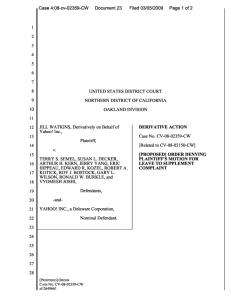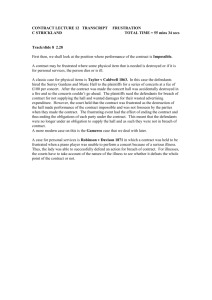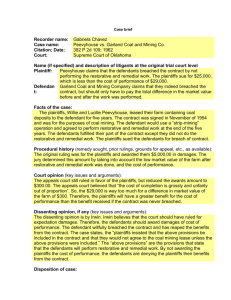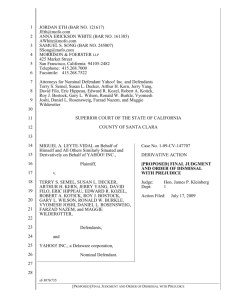class action
advertisement
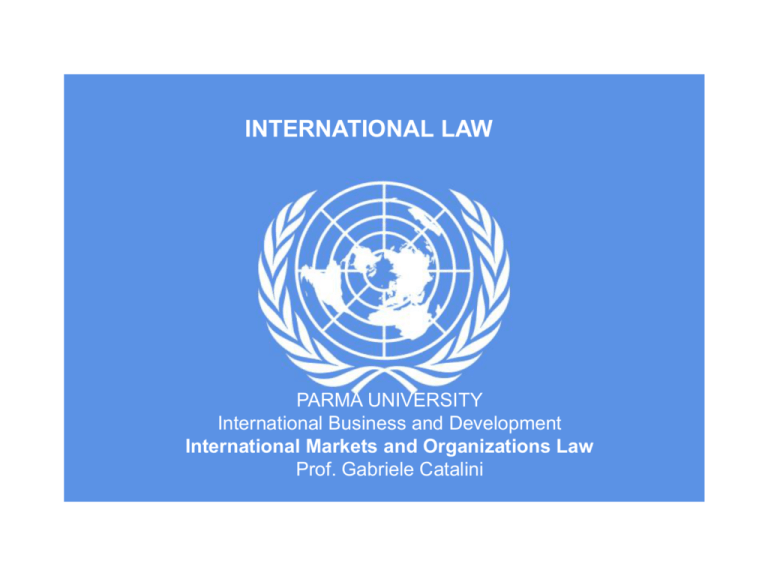
INTERNATIONAL LAW PARMA UNIVERSITY International Business and Development International Markets and Organizations Law Prof. Gabriele Catalini CLASS ACTION: U.S. AND ITALY APPROACHES DEFINITION In law, a class action or a representative action is a form of lawsuit in which a large group of people collectively bring a claim to court and/or in which a class of defendants is being sued. HYSTORY • Medieval Europe: England 1125: record of a few individuals' representing a large group of people in legal suits. • First Suit: 1309 a Discart vs. Otes case. • Rule 48: 1833: U.S. law first introduced group litigation • Rule 38: allowed absent parties to be represented as members of the prosecuting class. • Rule 23: Rule 38 became Rule 23 and "opt out“ was introduced • Private Securities Litigation Reform Act” of 1995: new rules in securities class action lawsuit. • Class Action Fairness Act of 2005: expansion of federal jurisdiction over many large classaction lawsuits in the United States. U.S. FEDERAL CLASS ACTIONS • Class action lawsuits may be brought in federal court if the claim arises under Federal Rules of Civil Procedure Rule 23 and 28 U.S.C.A. § 1332 (d) • It is also possible to bring class action lawsuits under state law • Typically, federal courts are thought to be more favorable for defendants and state courts more favorable for plaintiffs. “CANT” CHARACTERISTICS 1 Numerosity - the class must be so large as to make individual suits impractical 2 Commonality - there must be legal or factual claims in common 3 Typicality - the claims or defenses must be typical of the plaintiffs or defendants 4 Adequacy of Representation - the representative parties must adequately protect the interests of the class 5. common issues opposed to individual fact-specific conflicts between class members and the defendants 6. class action, instead of individual litigation, is a superior vehicle for resolution of the disputes at hand STATE CLASS ACTIONS • Since 1938, many states have adopted rules similar to the FRCP (Federal Rules of Civil Procedure) • However, some states have civil procedure systems which deviate from the federal rules • Some states, do not provide for any class actions, while others, limit the types of claims that may be brought as class actions. How does a Class Action suit work? Step 1: Step 2: drafting a complaint filing it in court "serving" on the defendants defendants answer or challenge the complaint Step 3: a period of "discovery" takes place How does a Class Action suit work? Step 4: the plaintiff files motion to certify a class action. the defendants will file objections to certification. the Court will have a hearing. If plaintiffs win, the case will be certified. Step 5: Notice about member’s rights and deadlines for "opting out" Step 6: Trial or Settlement https://nutellaclassactionsettlement.com/ http://www.huffingtonpost.com/2012/04/26/ nutella-lawsuit_n_1457183.html Alperin v. Vatican Bank is a class action suit by Holacaust survivors against the Vatican Bank ("Institute for Works of Religion") and Franciscan Order ("Order of Friars Minor") filed in California on November 15, 1999. The case was initially dismissed as a political question by the District Court for the Northern District of California in 2003, but was reinstated in part by the Court of Appeals for the Ninth Circuit in 2005. That ruling has attracted attention as a precedent at the intersection of the Alien Tory Claims Act (ATCA) and the Foreign Sovereign Immunities Act (FSIA). The complaint against the Vatican Bank was dismissed in 2007 on the basis of sovereign immunity, but the case against the Franciscan Order continues as of 2009. According to Hart, "the case is extremely complicated and potentially massive, considering the large class spread across many countries. The Vatican bank was charged with laundering and convering "the Ustaša treasury, making deposits in Europe and North and South American, [and] distributing the funds to exiled Ustaša leaders including Pavelić. A principal piece of evidence against the Vatican is the "Bigelow dispatch", a October 16, 1946 dispatch from Emerson Bigelow in Rome to Harold Glasser, the director of monetary research for the U.S. Treasury Department. Former OSS agent William Gowen has also given deposition as an expert witness that in 1946 Colonel Ivan Babic’ transported 10 truckloads of gold from Switzerland to the Pontifical College. CLASS ACTION IN ITALY EUROPE'S ATTITUDE FOR THE CLASS ACTION The European Consumer Commissioner: “The old continent will never “go down [the American class action] road” with its “toxic cocktail” of contingency fees, punitive damages, and pretrial discovery”. HISTORY • 1970 - the first Italian debate took place • 2010, January 1st - the new consumer class action law became effective • Italian consumer associations announced they would launch class actions for some 450,000 small Italian investors who claim they have been “cheated” by banks who sold them Argentinian bonds Other «participants» of class action THE TERMS The Italian law has no retroactive effect, The Class Action Act allows claims based on torts occurring after August 15, 2009 FIRST RESULTS In less than a year, six significant class action lawsuits have been filed against both Italian and foreign defendants, making Italy’s number of class action lawsuits high in comparison to other countries with recently introduced class action laws. At least two of the cases seek extremely high damages, totaling €6.25 billion together (and some numbers suggest that damages sought could exceed €10 billion). FEATURES The class action law is the first law in Italy to provide for monetary damages in a class action, as previous laws only allowed for injunctions, marking extraordinary change in the Italian litigation system. These lawsuits are limited to four types of cases: •contracts, •product liability, •anti-competitive (anti-trust) practices, •and unfair commercial practices. THE DIFFERENCE FROM THE US LAW The law differs from the U.S. Federal Rule of Civil Procedure 23: in a number of areas, e.g., more restrictive class certification process; an “opt-in” basis; no discovery; absence of punitive damages. NEGATIVE TRENDS Consumer associations are proactively looking for class action opportunities and are advertising to attract and “recruit” potential plaintiffs. But they are not actual plaintiffs. So it is not clear: HOW and AT WHAT RATE the consumer associations will be “compensated” for their class action work; HOW and HOW MUCH they will pay the consumers; Do the consumer associations will advocate the specific interests of the class of plaintiffs they represent, or will pursue their own interests and/or the interests of their members as a whole? WHO MAY FILE? Entities that can act on behalf of the plaintiff: • Consumer association or committee with nationwide presence • Consumer/Investor groups (registered with the Italian Ministry of Productive Activities) • Promoters vis a vis Plaintiff The proceeding 1° Stage: Admissibility The class action is deemed inadmissible if: • The claim is unfounded • There is conflict of interest • The rights infriged upon are not homogenous • The lead plaintif is unable to adequately represent the interest of the class 1° Stage: Admissibility The lead plaintiff must be a consumer The lead plaintiff must have “an interest in the suit” The phase ends with a court decision Publicity and opt-ins • Public dissemination of the admissibility finding • A deadline for opting in is settled • Members must affirmatively opt in to the class • Decision on liability and damages can not be changed after the opting in. 2° Stage: Liability and Damages • Liability and damages are determined The court specifies: • Damage amount • Uniformly applicable criterion for each individual claim • No provision for punitive damages Final considerations • Italian consumer association vis a vis US plaintiff law firms • Italian consumer association have the possibility to shape the law • What’s next?
